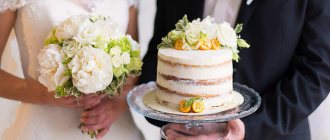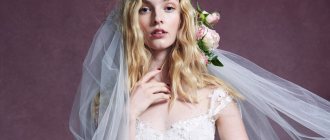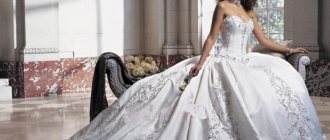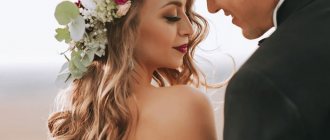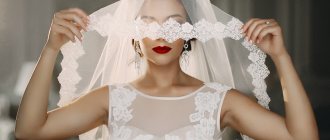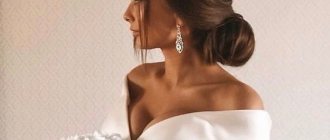A wedding veil is one of the most important wedding attributes and accessories for a bride’s wedding look. For many years and even centuries, it has been an integral element of wedding attire. During this time, not only its appearance changed, but also its symbolism. One of her first roles (around IV AD) was to protect the bride from the influence of demons and their temptations. Today, the veil has become a conventional symbol of virginity and purity, a beautiful decoration devoid of mysticism. But choosing the right wedding veil can be a difficult task. So, how to choose a veil to suit the style, appearance and figure of the bride? We have prepared a set of recommendations that will help you answer this question without any problems.
How to choose the type of wedding veil
As you begin your search for the perfect veil, you should consider the style you choose for yourself. Are you planning a wedding in a romantic style, or a more free, Hollywood style, or maybe in a rural area?
A classic dress is suited to a long veil, while a modern dress is suited to a veil of a fashionable, extravagant cut. An equally important criterion when choosing a veil is the cut and style of the wedding dress, as well as its characteristic details. For example, if the dress has a cutout at the back, the neckline should not be covered with a long veil.
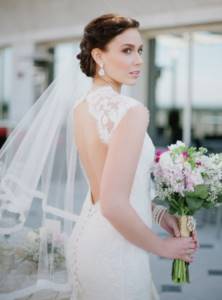
Another important issue is the bride’s figure. A well-chosen veil can help disguise some of your figure's imperfections while highlighting your best features.
Yes, indeed, the types of wedding veils vary greatly. Made of lace (for example, a Spanish “mantilla” with a comb in the hair), chiffon, organza. The types of veils also depend on the decorations and style used. A simple veil, decorated with rhinestones, beads, with lace edging or asymmetrical. One of the most important criteria in different types of wedding veils is length. And here we have a large field of activity: for example, a short veil with a veil, called a “blasher”, a veil to the elbows, to the waist, a classic veil that reaches the fingertips, as well as a “cathedral” veil, the length of which can reach three meters.
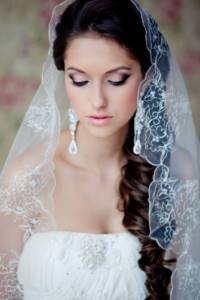
The longest wedding model
The first place among the longest veil models is occupied by “Italian lace” or “Cathedral”. This one, like the “Cathedral” one, is transparent and flowing model. However, unlike it, the length of the “Cathedral” model reaches 4-4.5 m. Sometimes it is decorated with original Italian lace, which is made by hand.
Thanks to her grace and beauty, it is absolutely easy to create the image of a real royal person. But when choosing this model, it is recommended to use an additional shorter and more practical version of the veil. The second option should be used after the main wedding ceremony.
General tips for choosing a wedding veil
Just as with all other elements of a bride's outfit, fitting for a veil is very important. It's better not to buy by eye.
The color of the veil should be the same as the color of the wedding dress - it is impossible, for example, for the dress to be white and the veil to be ivory.
For a princess-style wedding dress, it is best to choose a short veil, but the most versatile veil, suitable for almost all types and styles of wedding dresses, is an elbow-length veil. You can choose an elbow-length veil if you are not entirely sure which length will be most acceptable in our case.
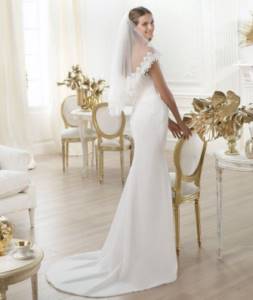
A lace veil goes well with silk dresses.
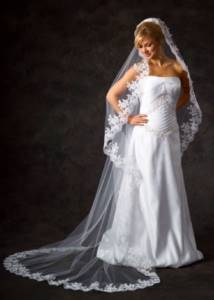
The veil should not overshadow the wedding dress and make a greater impression than the wedding dress itself.
A satin veil looks best with a satin dress.

The low-cut veil allows you to get a good look at your hairstyle. The veil should be secured under combed hair.
A little hairstyle above the veil visually adds a few centimeters to shorter brides.

One more note - be sure to remember that you should never iron the veil, as this can destroy it. It’s better to hang it on the back of the chair and let it hang freely for two weeks before the planned wedding date. This way we will get rid of unwanted folds.
Veil with headdress 2021 photo trends examples
No matter how wedding fashion changes, designers always try to stick to the classics. This also applies to the veil, because it plays a significant role in wedding traditions and rituals. Simply, adhering to one style or another, the veil can be slightly transformed or completely replaced with a veil, hoop, hat, etc. A hat is the most versatile wedding accessory: romantic and feminine, strict and flirty - a well-chosen headdress can highlight the best in the bride’s appearance.
A veil, as you know, is considered a symbol of a girl’s purity and innocence, so if you are pregnant or getting married for the second time, give preference to a wedding hat. As a last resort, you can wear a veil for a wedding ceremony or wedding, and then during a walk, during a photo shoot and a banquet, change it to a hat. The wedding hat is selected taking into account the style of the dress, height, age and even face shape.
Hats with wide brims are suitable for tall brides, while smaller, more fragile girls should remember one simple rule: “The brim of a hat should not exceed the width of a short woman’s shoulders.” Small hats should be avoided by overweight women. Those with a thin face should opt for “flat” hats with wide brims, while those with a fuller face should opt for hats with loosely curved brims.
Wedding veil and bride's figure
One of the factors that a bride should be guided by when choosing a wedding veil is the advantages and disadvantages of her own figure. For example, wide hips look flattering with a veil that ends just at or slightly below the hip line, as well as with an ornate veil. For petite brides, a short veil is suitable - it does not shorten the silhouette. To hide the width of your shoulders, choose a veil that ends in front of them or slightly behind the line. The rule is always the same - if we want to hide what is our weak side, the veil should end exactly in this place. But these are just general recommendations; now let’s look at the issue of length in more detail.
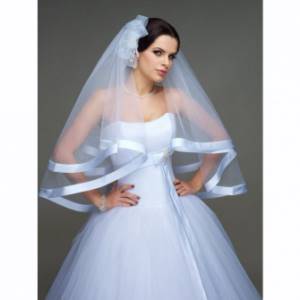
Veil fan
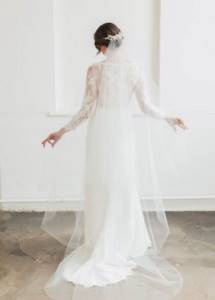
This is a narrow gathered veil that is attached to a decoration or the bottom of the hairstyle.
. Then towards the bottom it becomes wider and flows elegantly. A convenient option that will not interfere throughout the day.
How to choose the length of a wedding veil?
Short veil - a very practical veil about fifty centimeters long, often with a veil that covers the face, ideal for long dresses, for retro dresses, stylized in the 50s, for dresses with a simple cut or very flared, emphasizing the waist; Also, such a veil has proven itself on women with short hair.
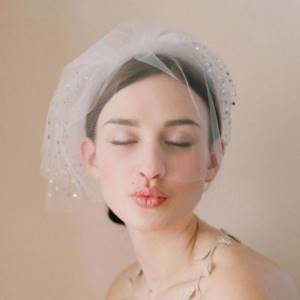
A medium length veil - approximately 60-70 cm, reaching the chest in front and the belt in the back, is valued due to the fact that it suits most wedding dresses and looks exceptionally well with richly decorated dresses.
A waist-length veil is recommended for brides who prefer classic or A-shaped dresses. You can choose single-layer, multi-layer, with a diadem or with a tiara.
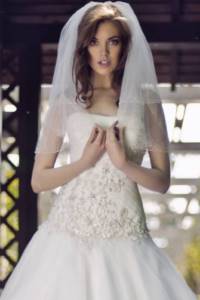
Long veil - has a length of 90-100 cm and reaches the hip line. This is perhaps the most popular length. This veil is suitable for both dresses with rich decorations and the most modest models, although with one caveat - it is better not to combine it with dresses up to mid-calf or 7/8 length, since such a combination visually reduces the length of the silhouette.
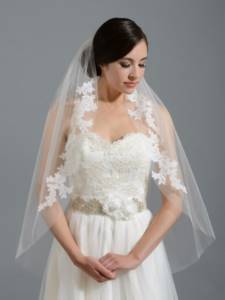
An almost floor-length veil - the key word here is “almost” - is recommended for tall women; it looks very flattering in combination with a mermaid dress.
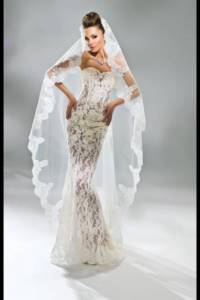
“Church” veil (dress with a train) - here we come to a veil that goes perfectly with wedding dresses that have a train, but do not forget that the veil should be slightly longer than the train.
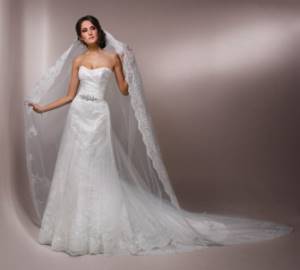
The cathedral veil has the longest length. This type of veil can often be seen while watching royal weddings on air. The longest ones even reach several tens of meters and majestically stretch behind the bride.
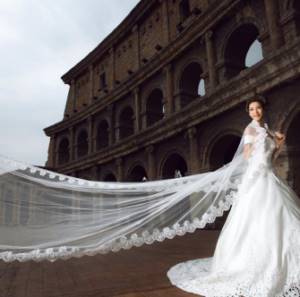
Veil mantilla
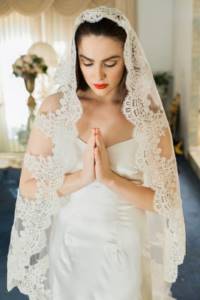
This option was popular among members of the Spanish royal court. This veil can be of different lengths; its main feature is lace inserts along the edge.
.
A very feminine option, but keep in mind that makeup and hairstyle should be as natural as possible. Otherwise the image will be overloaded. This option is suitable for those with rounded features
- the lace edge will help visually lengthen the face.
How to replace a wedding veil?
Not every woman dreamed from childhood that the main element of her dress would be a long snow-white veil... and, in principle, a veil in general. Often ladies want to go for a more traditional look, but sometimes they are ready for something more extravagant and are looking for alternative head decorations that can replace the classic veil. What to do in this case? Fortunately, wedding fashion designers have long begun to take this kind of demand into account, so brides have a fairly wide choice at their disposal. Having abandoned the wedding veil, you can choose one of the following accessories:
- hat with small or large brim
- tiara - gives the look of a princess, suitable for traditionally cut dresses
- comb, hairpins - their main advantage is that they are suitable for all types and styles of wedding dresses, while helping to create a complex hairstyle
- flower decorations - fresh flowers help create a delicate and romantic look; they can be pinned into either loose hair or a bun.
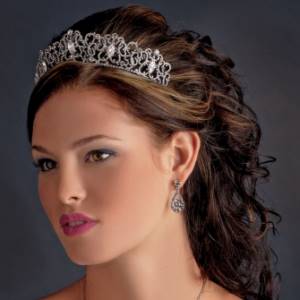
As you can see, there are many tips for choosing the perfect veil. But remember one thing and the most important thing - first of all, on your wedding day you should feel comfortable. And be guided by this feeling of comfort and convenience first of all when choosing a wedding dress and accessories. Even the most beautiful veil, perfectly adjusted in length, will not bring anything good if something in it bothers you.
(
2 ratings, average: 5.00 out of 5)

